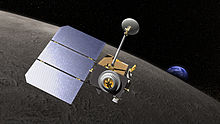NASA launches two space probes to the moon
Thursday, June 18, 2009

Image: NASA.
NASA launched the Lunar Precursor Robotic Program space probes, the Lunar Reconnaissance Orbiter (LRO) and the Lunar Crater Observation and Sensing Satellite (LCROSS) on board the Atlas V rocket at 5:32 p.m. EDT (2132 GMT) from Cape Canaveral Air Force Station. Due to nearby thunderstorms the launch was delayed about 20 minutes from the scheduled launch time of 5.12 p.m. EDT (2112 GMT). The mission will be NASA's first unmanned rocket expedition to the moon in a decade.
The aim of the LRO mission is to spend at least a year in a low polar orbit above the surface of the moon to gather neccesary data for future missions and longer lunar expeditions. It will be orbiting approximately 30 miles (48 km)s above the moon, trying to find safe landing sites, locating potential resources, characterizing the radiation environment and testing new technology.

The 2,300 pounds (1,043 kg) spent upper stage Centaur motor of the Atlas V launch vehicle will strike the surface of the moon at 9,000 km/h (5,600 mph) resulting in a 350 ton (317 metric ton) plume of debris rising between 6 to 30 miles (10 to 48 km) above the moon's surface. From this impact, scientists hope to be able to detect any water ice or vapor using the LCROSS satellite which will crash land nearby four minutes later. Astronomers who own amateur-class telescopes with apertures as small as 10 to 12 inches may be able to sight the ejecta cloud as it will have a period of brightness about one minute after impact.
The launch was originally planned for yesterday, but delayed for the launch of the Space Shuttle Endeavour, which was itself later delayed again due to another hydrogen fuel leak.
Sources
- William Harwood. "Atlas 5 rocket launches NASA moon mission" — C Net, June 18, 2009
- "LRO Overview" — NASA, June 18, 2009
- Paul Sutherland. "NASAs mission to bomb the moon" — Scientific American, June 17, 2009
- Brian Day. "LCROSS Observation Campaign" — NASA, June 16, 2009
- Brian Day. "Impact!" — NASA, June 16, 2009



